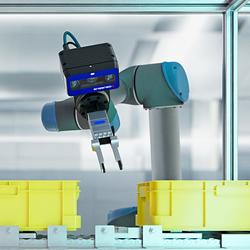Velodyne Lidar Showcases Groundbreaking Technology for Security and Safety Applications at the Unmanned Security Expo
Velodyne Lidar Sensors Power Aerial and Ground Robotics to Mitigate Security Threats
Velodyne Lidar, Inc. (booth #79) will exhibit its latest lidar technology for autonomous solutions in physical security and public safety at the Unmanned Security Expo New York. Velodynes lidar sensors enable essential mapping, navigation, and perimeter security capabilities in unmanned aircraft systems (UAS) and unmanned ground vehicles (UGV) for commercial, government, and first responder applications.
Unmanned Security Expo New York is co-located with ISC East and Infosecurity New York with more than 8,000 security and public safety professionals, buyers, and influencers expected to attend the events at the Javits Center on Nov. 14-15.
Velodyne will feature a live demonstration of its VLS-128 lidar sensor, which provides industry-leading range and resolution, detecting vehicles and people with unrivaled precision under challenging environmental conditions.
"Velodyne Lidar helps security and public safety organizations keep pace with the changing threat landscape in protecting people and assets," said Frank Bertini, UAV and Robotics Business Manager, Velodyne Lidar. "Our technology fuels autonomous aerial and ground solutions with a 360° view to see the entire environment around the system at a range of up to 300 meters. It is available in multiple form factors to support a variety of drone-based and ground-based applications."
One of the most critical advantages of Velodynes lidar is the ability to detect threats in a 3D space, specifically in the air. Most intrusion detection technologies today can only detect ground-moving objects, such as people and vehicles. With the advent of flying drones and sky taxis, it is now imperative to be able to detect aerial intrusions and react accordingly. Many of these new aerial threats are too small to detect with conventional radar. Other technologies, such as pan-tilt-zoom (PTZ) cameras, struggle with their limited field of view. Velodynes lidar is the key technology in autonomously monitoring entry points to critical infrastructure such as tunnels, nuclear facilities, and high-rise buildings.
Due to their small form factor and low power consumption, Velodyne Lidars sensors are designed to facilitate integrating UAS and UBV devices with ground stations. Velodyne provides comprehensive documentation and support, as well as an expansive, global third-party integrator network. Velodyne sensors have built-in Robot Operating System (ROS) integration and can be daisy-chained together to create a cohesive network of multiple sensors.
If you are a security professional who is interested in seeing Velodyne Lidar at the Unmanned Security Expo in New York City, on Nov. 14-15th, please contact Frank Bertini at fbertini@velodyne.com to secure a complimentary one-day hall pass.
About Velodyne Lidar
Founded in 1983 and headquartered in Silicon Valley, Velodyne is a technology company known worldwide for its real-time 3D lidar computing and software platforms. The company evolved after founder David Hall invented the HDL-64 Solid-State Hybrid lidar sensor in 2005. Since then, Velodyne Lidar, Inc. emerged as the unmatched market leader of real-time 3D vision systems used in a variety of commercial applications including autonomous vehicles, vehicle safety systems, mobile mapping, aerial mapping, and security. Its products range from the high-performance, surround view Ultra-Puck™ VLP-32, classic HDL-32/64 and cost-effective VLP-16, the new VLS-128, to the upcoming, hidden Velarray™. Velodynes rich suite of perception software and algorithms are the key enablers of its perception systems. Velodyne supports customers from offices in San Jose, Detroit, Frankfurt, and Beijing. For more information, visit http://www.velodynelidar.com.
Featured Product

3D Vision: Ensenso B now also available as a mono version!
This compact 3D camera series combines a very short working distance, a large field of view and a high depth of field - perfect for bin picking applications. With its ability to capture multiple objects over a large area, it can help robots empty containers more efficiently. Now available from IDS Imaging Development Systems. In the color version of the Ensenso B, the stereo system is equipped with two RGB image sensors. This saves additional sensors and reduces installation space and hardware costs. Now, you can also choose your model to be equipped with two 5 MP mono sensors, achieving impressively high spatial precision. With enhanced sharpness and accuracy, you can tackle applications where absolute precision is essential. The great strength of the Ensenso B lies in the very precise detection of objects at close range. It offers a wide field of view and an impressively high depth of field. This means that the area in which an object is in focus is unusually large. At a distance of 30 centimetres between the camera and the object, the Z-accuracy is approx. 0.1 millimetres. The maximum working distance is 2 meters. This 3D camera series complies with protection class IP65/67 and is ideal for use in industrial environments.
